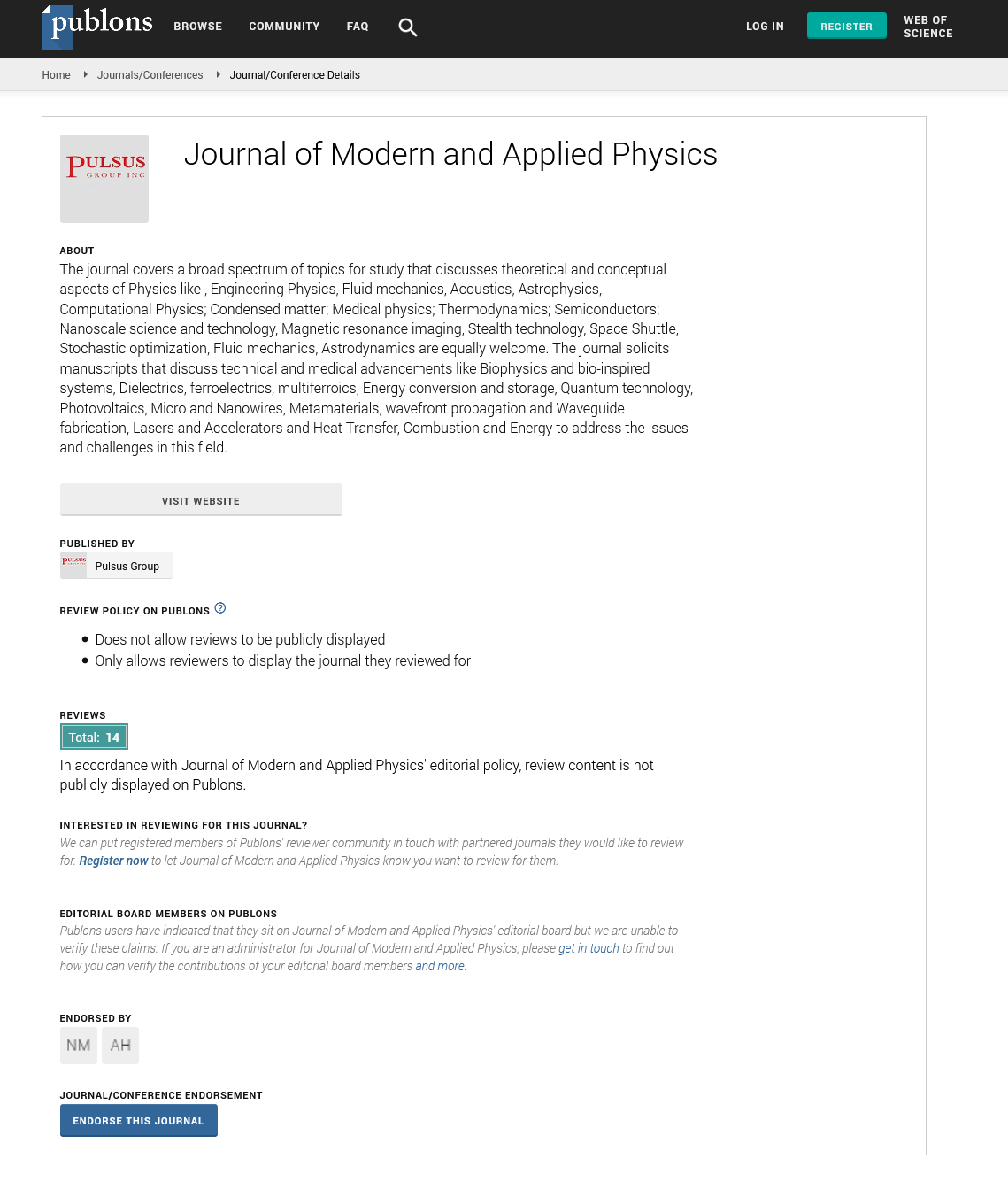Generalized thermo-diffusion interaction in a thermally conductive elastic medium with temperature dependent diffusivity
Received: 26-Jul-2022, Manuscript No. PULJMAP-22-5249; Editor assigned: 27-Jul-2022, Pre QC No. PULJMAP-22-5249(PQ); Accepted Date: Aug 16, 2022; Reviewed: 29-Jul-2022 QC No. PULJMAP-22-5249(R); Revised: 29-Jul-2022, Manuscript No. PULJMAP-22-5249(R); Published: 20-Aug-2022, DOI: 10.37532/puljmap.2022 .6(4); 01-02.
This open-access article is distributed under the terms of the Creative Commons Attribution Non-Commercial License (CC BY-NC) (http://creativecommons.org/licenses/by-nc/4.0/), which permits reuse, distribution and reproduction of the article, provided that the original work is properly cited and the reuse is restricted to noncommercial purposes. For commercial reuse, contact reprints@pulsus.com
Abstract
This paper aims to examine the transient thermo-diffusion responses for a half-space with changing thermal conductivity and diffusivity within the framework of extended thermo-diffusion theory. The surface of the half-bounding space is tractionless and subject to a time-varying thermal shock, but it is assumed that the chemical potential is a known function of time. Due to the complexity of the nonlinear equations, the finite element method is used to solve them. The results are produced numerically and visually. Through the use of parameter studies, the effects of changing thermal conductivity and diffusivity on the response are investigated. Researchers seek to gain a better understanding of how thermo-mechanical fields interact in actual materials using the findings of this study. In order to verify the accuracy of the suggested method, the behaviour of physical quantities for numerical solutions is examined and compared with numerical results and analytical cases where the new parameter is ignored.
Keywords
Tractionless; Thermo Diffusion
Introduction
Researchers intend to use the findings of this study to better comprehend how thermo-mechanical fields interact in actual matmaterials. By disregarding the new parameter, numerical results and analytical situations are compared, and the behavior of physical quantities for numerical solutions is examined to confirm the accuracy of the suggested method. As the temperature increases from 1°C to 400°C, ceramic loses 45% of its thermal conductivity, according to Godfrey. On the other hand, the diffusivity is often inversely proportional to the concentration of the diluent. This form of concentration dependence is seen in most systems. Thermal conductivity and diffusivity may normally be calculated using a linear or exponential equation. It is necessary to examine mechanical behavior with different material properties. The earlier uncoupled model's intrinsic contradiction—that elastic changes have no effect on temperature led Biot to create the coupled thermo elastic theory. Both theories' heat equations are of the diffusion type, which suggests that heat waves may travel at any speed, in opposition to scientific observations. With their expanded thermoelasticity theory, the concept of thermal relaxation time to the conventional Fourier Law of Heat Conduction (LS). In the examples above, temperature plays a significant role in the diffusion process, and it is crucial to understand T the interactions between temperature, strain, concentration, and other variables. The thermoelastic diffusion theory for elastically deformed solid structures was initially developed by Nowacki , who also produced a number of important corollaries, results, and field-governing equations. Thermo elastic diffusion models that are connected to this one anticipate an illimitable rate of thermal wave propagation. The Lord-Shulman theory led to the first development of the generalized thermo elastic diffusions model. overcame this erroneous finding by incorporating diffusions relaxation parameters into the well-known Fick's law of mass diffusions. For inhomogeneous materials, Burchuladze investigated the non-stationary issue of generalised elastothermo-diffusions. This universal model is said to be capable of addressing a wide range of heat transfer models and bridging the gap between microscopic and macroscopic procedures. Kumar et al. studied the effects of thermal and diffusion phase-lags in an axisymmetric heat supply plate. Thermodiffusion in an infinite material with a cylinder hole was studied. Abbas and Marin looked at the analytical solutions to a two-dimensional generalized thermoelastic diffusions issue caused by a laser pulse. Considering the generalised magneto-thermoelastic theory, Othman and Eraki by Abouelregal and colleagues. According to Abbas et al., the transverse response of heat sources using the finite element approach plane of isotropic thermoelasticity.
Lotfy investigated how different thermal conductivity in semiconducting media subject to photo-thermal diffusions. For extended thermoelastic diffusions theories of higher order with time fractional four-phase lags. The uniqueness, reciprocity, and variational principle were all presented by Molla and Mallik models. The effects of the rotating thermo-elastic system were studied by Abbas and Seingh utilising the finite element method to create a plane with diffusions. Kirchhoff's transform is used to A thermodiffusion elastic thick film's transient responses have been explored .thermal conductivity and diffusivity variations on a circular plate. Sharma et al. have thoroughly investigated the thermal conductivity and thermal diffusivity of two-temperature thermoselastic diffusion plates with variable diffusion. In order to study the generalised thermo-diffusions bi-layered structure under changing the- -rmal conductivity and diffusivity. utilised the Kirchhoff's transform. Generalized thermoelastic models have presented a variety of issues in recent years, as see In an elastic material, the effects of altering thermal conductivity and diffusivity are examined in this work. The finite element method has been used to produce numerical solutions for the fields that have been investigated. The results are then shown visually. According to the numerical analysis, mechanical and thermal waves can only propagate at a certain speed due to the changing thermal conductivity and diffusivity without Kirchhoff's transform. In order to verify the accuracy of the suggested method, the behavior of physical quantities for numerical solutions is examined and a comparison between analytical instances and numerical findings is generated by disregarding the new parameter.





